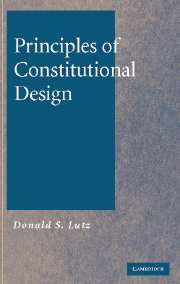Book contents
- Frontmatter
- Contents
- Preface
- Acknowledgments
- Principles of Constitutional Design
- 1 Constitutionalism: An Initial Overview and Introduction
- 2 Sovereignty
- 3 Popular Sovereignty
- 4 The Separation of Powers
- 5 Analyzing the Interaction between Popular Control and the Separation of Powers in the Amendment Process
- 6 Matching a Government to a People
- 7 An Overview of the Constitutional Design Project
- 8 An Underlying Constitutional Logic: Rational Actors?
- Index
Preface
Published online by Cambridge University Press: 29 July 2009
- Frontmatter
- Contents
- Preface
- Acknowledgments
- Principles of Constitutional Design
- 1 Constitutionalism: An Initial Overview and Introduction
- 2 Sovereignty
- 3 Popular Sovereignty
- 4 The Separation of Powers
- 5 Analyzing the Interaction between Popular Control and the Separation of Powers in the Amendment Process
- 6 Matching a Government to a People
- 7 An Overview of the Constitutional Design Project
- 8 An Underlying Constitutional Logic: Rational Actors?
- Index
Summary
What follows will disappoint those looking for a “how-to” manual on constitutional design. Certainly there is much here that can be used by those writing or rewriting a constitution, but the major intent of this book is to help us understand constitutional design rather than lay out guidelines for constitutional construction – to help us think about the constitutional project rather than direct us toward specific institutional or constitutional outcomes. Even if one wanted to provide a set of instructions for those framing a constitution, it would be unwise for an outsider to do so. A fundamental fact about constitutional design is that there is no optimal model, no clear set of rules for matching a people and their situation with a set of institutions, and no inherently stable or superior constitutional system. We do know a great deal more about institutional design than Aristotle did, and even a good deal more than we did half a century ago. The empirical knowledge we now possess, however, tends to be piecemeal, theoretically unfocused, and sometimes contradictory. As important as the contributions of empirical and analytic approaches have been over the past half century, there is no substitute for just backing off and asking, How do we go about thinking about constitutionalism and the design of constitutions as an integrated project? That is the deep focus of this book, and that is why it is best to think of it as an exercise in political theory.
- Type
- Chapter
- Information
- Principles of Constitutional Design , pp. ix - xiiPublisher: Cambridge University PressPrint publication year: 2006

